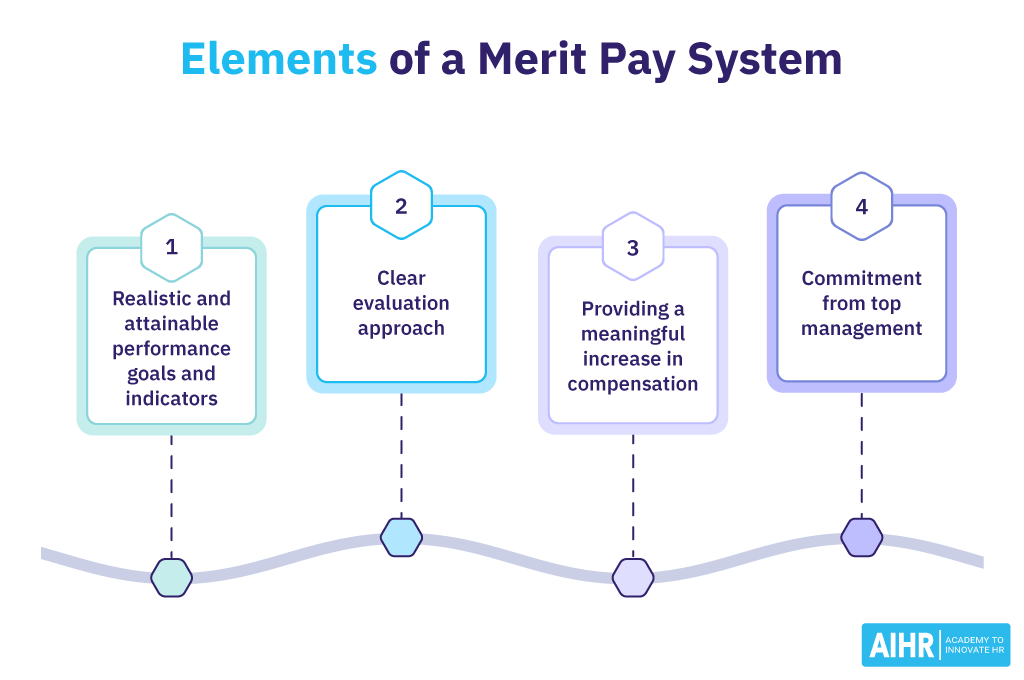Merit Pay
What is merit pay?
Merit pay is a compensation approach that gives employees an increase in their base salary or provides bonuses based on their performance. Employers use it to ensure they are rewarding their best-performing employees.
Merit pay can take the form of a merit increase in salary, commission, or bonuses.
How does merit pay work?
An organization that uses merit pay implements a set of performance standards for employees and well-defined goals that are aligned with that standard.
A clear evaluation approach is created to understand if employees are meeting these performance standards. This might be a weekly, monthly, quarterly, bi-annual, or annual check-in and review. Merit pay is determined over a period of time, usually across the organization’s fiscal year.
Organizations should develop fair and clear guidelines for merit pay, which should include a rigorous feedback and review component. Merit pay is a type of what is often referred to as “pay for performance” .Typically, merit pay is quite popular with target-based jobs, such as marketing or sales, but it can also be implemented more broadly.

What are the advantages of merit pay?
The advantages of merit pay include:
- Increases in productivity by employees that are motivated by incentives.
- Improving retention rates with high-performing talent that benefit from merit pay
- Allowing managers to differentiate pay to reward high performers.
- Recognizing individual performance. Even when a team is not performing up to standard, merit pay allows individual employees to be rewarded if their performance is excellent.
- Continuously encouraging high-performance standards in the organization.
What are the disadvantages of merit pay?
Merit pay also has some disadvantages. Namely, it:
- Often depends on a subjective process.
- Can cause feelings of favoritism, jealousy, and unfairness.
- Often results in unhealthy competition in the organization.
- Can cause conflict between employees that are ‘competing.
How to implement a merit pay system
1. Determine your merit pay strategy
There are two strategies you can use to determine how you will implement merit pay in your organization. The first is to use the average pay of each employee to determine a benchmark. The benchmark can, for example, be based on a performance scale:
- Exceeds expectations = $300 bonus
- Average = $150 bonus
- Below average = $75 bonus
- Unsatisfactory = no bonus
The other strategy is to align your merit pay with the goals of the organization. This means that employees in a particular department or sub-department in your organization receive higher merit pay. If, for example, your organization is sales-oriented, then you might want to allocate a higher merit pay budget to your sales team.
2. Define your organization’s objectives
Create a clear understanding of the goals for your organization for the year. From the organization’s goals, each employee has to have their own goals. Your merit pay system will underline and support these goals throughout the year as you reward employees for actively working towards them.
3. Outline performance standards
Develop clear guidelines for employees to understand what is bad, good, and excellent and how they are linked to merit pay. For each performance standard, it should be clear what the corresponding merit pay would be.
4. Develop a merit pay policy
Using the outcomes of your merit pay strategy, performance management system, and objectives, develop a merit pay policy. This policy should include:
- Calculation of merit pay
- Timeline of merit pay increases
- Performance standards policy
- Rewards structure
The Fair Labor Standards Act (FLSA) does not address the issue of merit pay, but it is always a good idea to check the laws in your state or region to make sure you are compliant.
5. Communicate the merit pay structure to all employees
All employees are entitled to have a clear understanding of how the merit pay structure works. This should be communicated during onboarding, as well as on an annual basis, and if there are any changes. Objectives for all employees should be clear, stored, and documented. All performance conversations should also be stored and documented.
To support the implementation of a merit pay system, use technology to make it easy. Also, use constant feedback to ensure it is improved each year.
Who is involved in creating the merit pay system?
- Human Resources – HR is responsible for implementing the merit pay system, developing the policy, and upholding the fairness of any merit pay increases.
- Finance – Your finance department is responsible for allocating the merit pay budget for the year. The merit pay budget should be linked to the organization’s financial performance for the year (i.e., the merit pay should be used as a strategic tool to increase the profits/sales for an organization).
- Management – Managers are responsible for communicating any merit pay increase, overseeing employee eligibility, and measuring performance.







